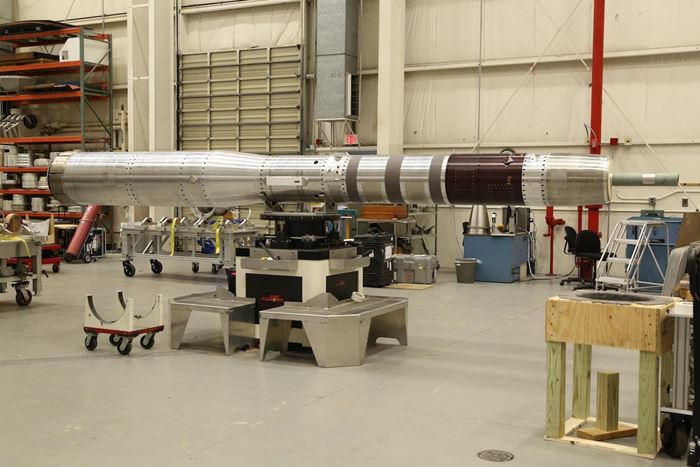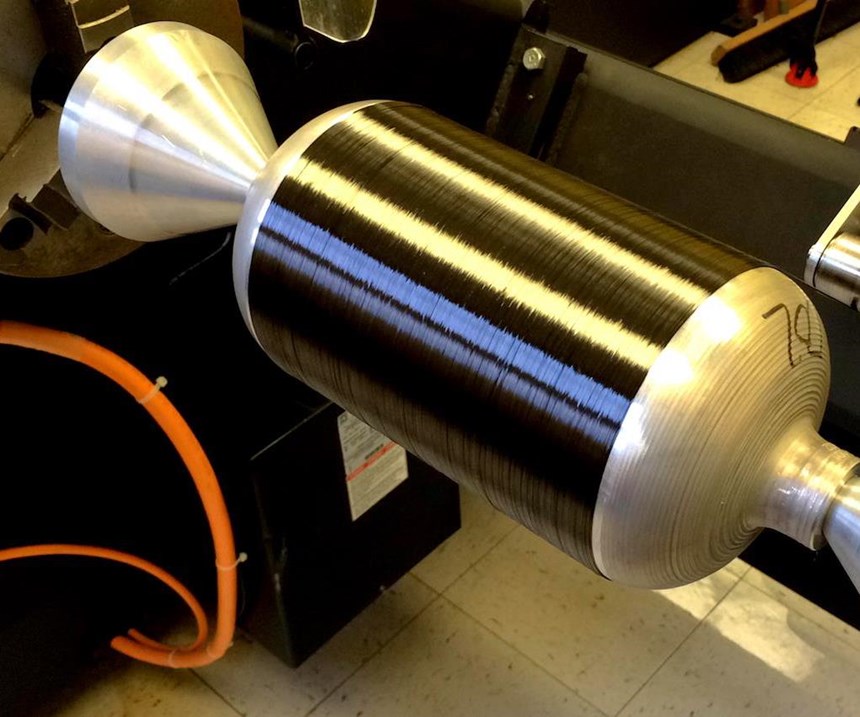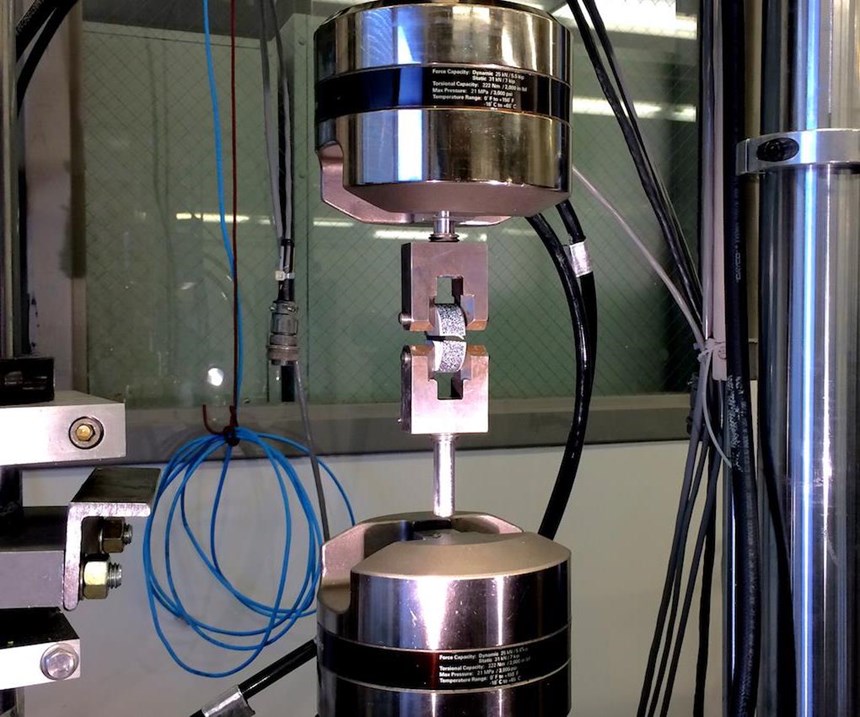NASA exploring using carbon nanotube for aerospace applications
NASA worked with Nanocomp to produce carbon nanotube (CNT) fibers to fabricate a carbon nanotube Composite Overwrap Pressure Vessel.
NASA’s Space Technology Mission Directorate (STMD) is interested in nanotechnology – an approach that can reduce the mass and improve the performance of aerospace systems. For example, NASA computer modeling analysis has shown that composites using carbon nanotube reinforcements could lead to a 30 percent reduction in the total mass of a launch vehicle.
“No single technology would have that much of an impact to reduce the mass of a launch vehicle by that much,” says Michael Meador, program element manager for lightweight materials and manufacturing at NASA’s Glenn Research Center in Cleveland, Ohio. “I’m not trying to be cliché, but that is a game changer.”
Soon-to-fly hardware will test the tensile properties of a carbon nanotube fiber-based composite tank over that of conventional carbon fiber epoxy composites. A Composite Overwrapped Pressure Vessel (COPV) took to the skies aboard a sounding rocket launched from NASA’s Wallops Flight Facility in Virginia on May 16.
“We’re going to use the COPV as part of a cold-gas thruster system,” Meador says, noting that this involves moving the rocket’s payload during its flight, as well as spinning up the payload to improve the rocket’s aerodynamics during its descent to Earth. “We are one experiment in that payload, but it’s a pioneering flight. This is first time that carbon nanotube-based composites have been flight-tested in a structural component,” he says.
The COPV project has involved several NASA centers – Glenn Research Center, Langley Research Center, the Marshall Space Flight Center – as well as industry. NASA collaborated with Nanocomp (Merrimack, NH) to make nanotube yarns and sheets, with the space agency developing specialized processing methods to fabricate COPVs.
“We were interested not just in developing high-strength composites from carbon nanotube yarns but also in demonstrating their performance by building an actual component and flight testing it,” Meador says. “The COPV flight test will go a long way in showing that these materials are ready for use in future NASA missions.”
The suborbital rocket flight of a COPV is a first step, says Emilie Siochi, a research materials engineer at NASA’s Langley Research Center. “This COPV represents the first large item that we’ve built” by turning nanotube yarns into composites. Early on at the start of the initiative, she says carbon nanotube fiber material was only available in small quantities. That needed to change.
“We had to improve the properties, improve the quality and the quantity,” Siochi says. The NASA-industry relationship was invaluable to scale up the material for space agency use, she says, and qualifying the COPV for a flight test has assisted in maturing the technology too.
“There’s potential for the structural properties of carbon nanotubes to be much stronger than carbon fiber composites, now the state of the art for structural material,” Siochi says. “So if it’s stronger, we’ll be able to build lighter structures needed for access to space.”
Meador sees a bright and long-lasting future for carbon nanotube materials.
“When we first started to get into nanotechnology research we were looking at where did it make sense for NASA to invest…where could a huge payoff be for the agency, be it in weight savings, performance, or reduced power consumption,” Meador suggests.
There’s more work to be done in terms of improving the material’s mechanical properties, as well as fabricating the yarn fiber in quantities to make it competitive with conventional carbon fiber.
“There’s a big payoff, not just for aerospace applications,” Meador says. Use of carbon nanotube materials, say in cutting down the weight of ground transportation vehicles, could lead to a huge savings from less fuel consumption and also lessening carbon dioxide emissions. Likewise, the insertion of the technology into aircraft is another area that deserves further attention, he adds.
“We’re not looking at magic materials. Rather, we’re finding that when you get down to the nanoscale, there are certain features of materials at that scale that give rise to new properties, new physics that you don’t see above that scale,” Meador says. “And that’s what it’s all about. Seeing how you can control and exploit those properties.”
Related Content
One-piece, one-shot, 17-meter wing spar for high-rate aircraft manufacture
GKN Aerospace has spent the last five years developing materials strategies and resin transfer molding (RTM) for an aircraft trailing edge wing spar for the Airbus Wing of Tomorrow program.
Read MoreA new era for ceramic matrix composites
CMC is expanding, with new fiber production in Europe, faster processes and higher temperature materials enabling applications for industry, hypersonics and New Space.
Read MoreInfinite Composites: Type V tanks for space, hydrogen, automotive and more
After a decade of proving its linerless, weight-saving composite tanks with NASA and more than 30 aerospace companies, this CryoSphere pioneer is scaling for growth in commercial space and sustainable transportation on Earth.
Read MorePlant tour: Spirit AeroSystems, Belfast, Northern Ireland, U.K.
Purpose-built facility employs resin transfer infusion (RTI) and assembly technology to manufacture today’s composite A220 wings, and prepares for future new programs and production ramp-ups.
Read MoreRead Next
CW’s 2024 Top Shops survey offers new approach to benchmarking
Respondents that complete the survey by April 30, 2024, have the chance to be recognized as an honoree.
Read MoreFrom the CW Archives: The tale of the thermoplastic cryotank
In 2006, guest columnist Bob Hartunian related the story of his efforts two decades prior, while at McDonnell Douglas, to develop a thermoplastic composite crytank for hydrogen storage. He learned a lot of lessons.
Read MoreComposites end markets: Energy (2024)
Composites are used widely in oil/gas, wind and other renewable energy applications. Despite market challenges, growth potential and innovation for composites continue.
Read More



























